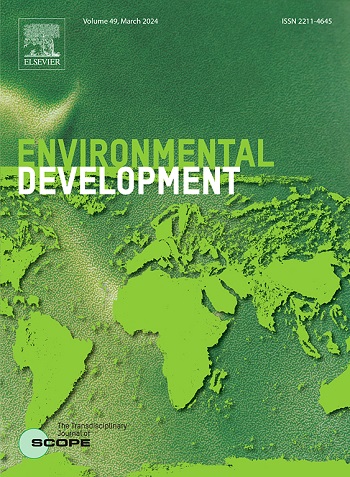BRValuation: a systematic comparison of ecosystem services across Brazilian biomes and ecosystems
IF 5.3
2区 环境科学与生态学
Q2 ENVIRONMENTAL SCIENCES
引用次数: 0
Abstract
The identification, classification, and valuation of Ecosystem Services (ES) are essential in highly diverse regions such as the Amazon and the Atlantic Forest in Brazil. Although publications on ES have proliferated over the past three decades, the International Classification of Ecosystem Services (CICES) is relatively recent, and studies integrating CICES and ES valuation remain scarce. In this study, we evaluated a comprehensive list of publications on ES classification across Brazil's natural and artificial biomes and ecosystems, following the CICES framework. Our methodology involved a stepwise classification of ES studies, encompassing all relevant literature published up to 2023. The CICES classes significantly influenced ES identification and valuation, regardless of spatial scale (ecosystem or landscape). Regulating services were the most reported, followed by provisioning, cultural, and supporting services, respectively. In addition to natural environments, agroecosystems emerged as the third most important source of ES, with provisioning (e.g., aquaculture) and cultural (e.g., recreation) services outweighing regulating and supporting services. Regulating services predominated in the Amazon and Atlantic Forest, while cultural services were more frequently associated with marine environments. Although the average valuation of ES did not differ significantly between natural and artificial environments, natural ecosystems such as forests and watersheds hosted a greater number of ES. Notably, artificial environments like fishponds contributed disproportionately to the total ES valuation due to high provisioning service values. Despite the predominance of ES research in natural environments, the valuation of provisioning services in artificial settings may be overestimated — often due to outlier values — reflecting a perception that ties the greatest ES values to direct human use of natural resources. While efforts to establish a unified framework for ES classification and valuation are ongoing, caution is advised when assessing the value of resources directly linked to human consumption, particularly in artificial systems. In conclusion, the classification and valuation of ES in Brazil are still in a developmental stage and demand more rigorous scientific approaches to effectively inform decision-making at both local and regional levels. This paper discusses the need for standardized valuation protocols across biomes and ecosystems to advance this goal.
巴西生物群落和生态系统生态系统服务的系统比较
在亚马逊和巴西大西洋森林等高度多样化的地区,生态系统服务(ES)的识别、分类和评估至关重要。尽管在过去的30年里,关于生态系统服务的出版物激增,但国际生态系统服务分类(CICES)是相对较新的,将CICES和生态系统服务评估相结合的研究仍然很少。在这项研究中,我们根据CICES框架评估了巴西自然和人工生物群落和生态系统ES分类的综合出版物列表。我们的方法包括对ES研究的逐步分类,包括截至2023年发表的所有相关文献。无论空间尺度(生态系统或景观),CICES分类都显著影响生态系统的识别和评价。报告最多的是管理服务,其次分别是供应、文化和支持服务。除自然环境外,农业生态系统成为生态系统的第三大重要来源,其中供应(如水产养殖)和文化(如娱乐)服务超过了调节和支持服务。管制服务在亚马逊和大西洋森林中占主导地位,而文化服务则更多地与海洋环境有关。虽然生态系统的平均价值在自然环境和人工环境之间没有显著差异,但森林和流域等自然生态系统承载了更多的生态系统。值得注意的是,由于提供服务的价值较高,鱼塘等人工环境对ES总估值的贡献不成比例。尽管自然环境中的生态系统研究占主导地位,但人工环境中供应服务的估值可能被高估——通常是由于离群值——反映了一种将最大的生态系统价值与人类直接利用自然资源联系起来的看法。虽然正在努力建立一个统一的ES分类和评估框架,但在评估与人类消费直接相关的资源价值时,特别是在人工系统中,建议谨慎行事。总之,巴西生态系统的分类和评价仍处于发展阶段,需要更严格的科学方法来有效地为地方和区域层面的决策提供信息。本文讨论了跨生物群系和生态系统的标准化评估协议的必要性,以推进这一目标。
本文章由计算机程序翻译,如有差异,请以英文原文为准。
求助全文
约1分钟内获得全文
求助全文
来源期刊

Environmental Development
Social Sciences-Geography, Planning and Development
CiteScore
8.40
自引率
1.90%
发文量
62
审稿时长
74 days
期刊介绍:
Environmental Development provides a future oriented, pro-active, authoritative source of information and learning for researchers, postgraduate students, policymakers, and managers, and bridges the gap between fundamental research and the application in management and policy practices. It stimulates the exchange and coupling of traditional scientific knowledge on the environment, with the experiential knowledge among decision makers and other stakeholders and also connects natural sciences and social and behavioral sciences. Environmental Development includes and promotes scientific work from the non-western world, and also strengthens the collaboration between the developed and developing world. Further it links environmental research to broader issues of economic and social-cultural developments, and is intended to shorten the delays between research and publication, while ensuring thorough peer review. Environmental Development also creates a forum for transnational communication, discussion and global action.
Environmental Development is open to a broad range of disciplines and authors. The journal welcomes, in particular, contributions from a younger generation of researchers, and papers expanding the frontiers of environmental sciences, pointing at new directions and innovative answers.
All submissions to Environmental Development are reviewed using the general criteria of quality, originality, precision, importance of topic and insights, clarity of exposition, which are in keeping with the journal''s aims and scope.
 求助内容:
求助内容: 应助结果提醒方式:
应助结果提醒方式:


